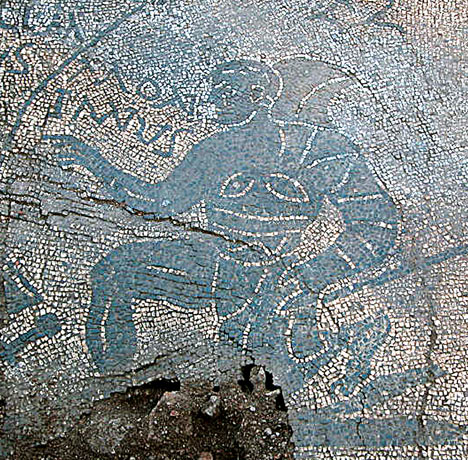Was this the real-life Gladiator?
30th April 2007

Young pretender: Russell Crowe as Maximus
With gritty heroism, Russell Crowe strode around the amphitheatre in the film Gladiator.
Now archaeologists have discovered a Roman hardman who may have been the real-life champion fighter.
A 2,000-year-old mosaic depicting the gladiator has been found by researchers working on the Villa dei Quintili, near Rome.
The villa was home to the Emperor Commodus, who is played by Joaquin Phoenix in the film, and loved gladiatorial combat.

Villa dei Quntili
In the mosaic, a gladiator named Montanus holds a trident and net, alongside a referee who is pronouncing him the victor over a prone opponent.
The mosaic's existence in the Emperor's house, suggests that he revered the gladiator.
However, Hollywood's fictional version was very different.
Crowe played a character called Maximus, a once-powerful Roman general who is condemned to the gladiator games after losing out in a power struggle with Commodus.
Eventually, they kill each other in a duel.

The Roman mosaic that depicts Montanus, a real-life gladiator holding a trident
Dr Riccardo Frontoni, who is leading the dig, said:
"Historically this is a very significant and exciting discovery because of the location where it was found at the Villa dei Quintili, which we know was Commodus's residence.
"It's close to the area where there was a small amphitheatre and the Emperor's love of blood sports is well-known.
The mosaics show the figure of a gladiator with the name Montanus.
"Next to him is a referee with the text "summa rudis", which is again very significant, as this was the name given to the top referees in gladiatorial combat and we can see him pointing the "virga"; at Montanus indicating him as the victor.
"It's possible that Montanus may have been a favourite of Commodusand the mosaic was dedicatedto him.
"The fact that such a scene exists at all in Commodus's villa is also significant as we know the Emperor liked to be the victorious one." Commodus, emperor from 180 to 192AD, had a passion for gladiatorial combat.
Occasionally he would enter the arena himself, dressed as a gladiator. This was considered scandalous as gladiators were regarded as low class.
dailymail.co.uk
30th April 2007

Young pretender: Russell Crowe as Maximus
With gritty heroism, Russell Crowe strode around the amphitheatre in the film Gladiator.
Now archaeologists have discovered a Roman hardman who may have been the real-life champion fighter.
A 2,000-year-old mosaic depicting the gladiator has been found by researchers working on the Villa dei Quintili, near Rome.
The villa was home to the Emperor Commodus, who is played by Joaquin Phoenix in the film, and loved gladiatorial combat.

Villa dei Quntili
In the mosaic, a gladiator named Montanus holds a trident and net, alongside a referee who is pronouncing him the victor over a prone opponent.
The mosaic's existence in the Emperor's house, suggests that he revered the gladiator.
However, Hollywood's fictional version was very different.
Crowe played a character called Maximus, a once-powerful Roman general who is condemned to the gladiator games after losing out in a power struggle with Commodus.
Eventually, they kill each other in a duel.

The Roman mosaic that depicts Montanus, a real-life gladiator holding a trident
Dr Riccardo Frontoni, who is leading the dig, said:
"Historically this is a very significant and exciting discovery because of the location where it was found at the Villa dei Quintili, which we know was Commodus's residence.
"It's close to the area where there was a small amphitheatre and the Emperor's love of blood sports is well-known.
The mosaics show the figure of a gladiator with the name Montanus.
"Next to him is a referee with the text "summa rudis", which is again very significant, as this was the name given to the top referees in gladiatorial combat and we can see him pointing the "virga"; at Montanus indicating him as the victor.
"It's possible that Montanus may have been a favourite of Commodusand the mosaic was dedicatedto him.
"The fact that such a scene exists at all in Commodus's villa is also significant as we know the Emperor liked to be the victorious one." Commodus, emperor from 180 to 192AD, had a passion for gladiatorial combat.
Occasionally he would enter the arena himself, dressed as a gladiator. This was considered scandalous as gladiators were regarded as low class.
dailymail.co.uk